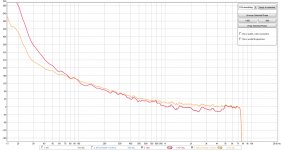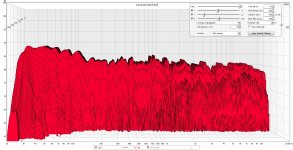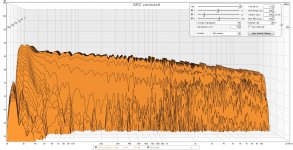Can I look at a revised mdat that includes the DRC corrections so I can look at all the data?
I think I would have to email that to you....
Jim, I think that analogy is not too far off.
The improvements to Room and Speaker are indeed the most difficult to solve the old fashioned way. Pardon me saying that. I should say passively. The FIR correction can make changes in time, it does cause a small delay though.
Evident in this correction it is not solving all of the problems (again, wrong word) in your setup. It did make improvements though, but not yet the snappy tight bass we ultimately want.
The improvements to Room and Speaker are indeed the most difficult to solve the old fashioned way. Pardon me saying that. I should say passively. The FIR correction can make changes in time, it does cause a small delay though.
Evident in this correction it is not solving all of the problems (again, wrong word) in your setup. It did make improvements though, but not yet the snappy tight bass we ultimately want.
Hmm... not much correction of the GD plot by DRC. It probably corrects to minimum phase behaviour?
Nice frequency response though, cleaner impulse, is the kicker at 25 ms left intact?
That's a deliberate feature but I expect it to fall way out of the correction window.
I don't think the GD was too bad to start with and may be good enough after this level of correction, but I'm not sure. Maybe look at it as frequency cycles rather than time in ms?
The kicker is actually very slightly altered and so should probably be switched off for the sweeps.
Greg, can you display phase too on the frequency plot?
And another note, DRC is usually correcting to minimum phase behaviour right? But I seem to recall it has an option to do linear phase?
Have you toyed with that, Greg? I wouldn't know how to yet but that might be the key to the time domain correction we're after here.
The plots from BWaslo show the effect of correcting phase with Rephase.
I know Audiolense can be run in minimum phase and linear phase mode:

The difference there is ticking that True time domain box.
Surely DRC must have something similar? I haven't found it yet though.
And another note, DRC is usually correcting to minimum phase behaviour right? But I seem to recall it has an option to do linear phase?
Have you toyed with that, Greg? I wouldn't know how to yet but that might be the key to the time domain correction we're after here.
The plots from BWaslo show the effect of correcting phase with Rephase.
I know Audiolense can be run in minimum phase and linear phase mode:
The difference there is ticking that True time domain box.
Surely DRC must have something similar? I haven't found it yet though.
Attachments
Last edited:
Here are the DRC corrected files so all can look.
https://www.gearslutz.com/board/11063338-post476.html
One of the things I wanted to look at with the DRC files were the distortion plots. They wont load. Nothing there.
Do you know whats up Greg?
Do you know whats up Greg?
Min phase response
I would say there is a big improvement in low freq min phase response. At 20 hz we're going from almost 180 deg to just a bit more than 60 deg. I have the PL stage of DRC set to linear phase which will allow some pre-echo in order to improve phase response.
I would say there is a big improvement in low freq min phase response. At 20 hz we're going from almost 180 deg to just a bit more than 60 deg. I have the PL stage of DRC set to linear phase which will allow some pre-echo in order to improve phase response.
Attachments
Yes, that's what I thought. But more should be possible. We see a nice arc where we would want flat phase to get the timing right.
From the DRC documentation I see this plot:

So clearly we could do more in the time domain. What is done here seems like getting everything to minimum phase, but the group delay follows the slope of the phase response.
It's something I haven't figured out yet in DRC but should be possible as the above example shows. Your starting point is better than what's shown in these graphs.
From the DRC documentation I see this plot:
So clearly we could do more in the time domain. What is done here seems like getting everything to minimum phase, but the group delay follows the slope of the phase response.
It's something I haven't figured out yet in DRC but should be possible as the above example shows. Your starting point is better than what's shown in these graphs.
Attachments
Last edited:
One of the things I wanted to look at with the DRC files were the distortion plots. They wont load. Nothing there.
Do you know whats up Greg?
You lose HD info once the file leaves REW. I don't know of a way to simulate that......
Last edited:
wesayso, As far as I know, the examples in the DRC documentation are done with the "normal" preset which has a window length of 10 cycles. So, yes, we can certainly do more, but my thinking was to start at the minimum level and crank it up when we know were on the right track. In the meantime, I'll try to show you whatever you want to see.
wesayso, As far as I know, the examples in the DRC documentation are done with the "normal" preset which has a window length of 10 cycles. So, yes, we can certainly do more, but my thinking was to start at the minimum level and crank it up when we know were on the right track. In the meantime, I'll try to show you whatever you want to see.
I posted a link to the new mdats a few posts ago so you wouldn't have to do this.
After a quick look (except distortion), most everything is better.
Nice work Greg!
But waterfalls (decay) wasnt one of them.
View attachment 484295
View attachment 484296
I am a bit slow here. Are you guys saying that you have applied a correction to Jim's system via DRC already? Or is this all theoretical at this point?
I am a bit slow here. Are you guys saying that you have applied a correction to Jim's system via DRC already? Or is this all theoretical at this point?
DRC has been applied to my mdat's
Greg, did you notice the huge change in the Step response in the example?
That long horizontal tail slowly going to zero is when it is time-coherent.
The corrected impulse did not show that kind of correction, but maybe more cycles are needed to get there. I never got that entirely but as you know I use long windows on top and bottom and shorter ones trough the midrange. But I haven't found a way to get it like I want it yet.
Could you show what an 8 cycle preset would to the STEP?
I see very positive things here, Jim does too. Just wondering what does what. We now have an almost anechoic room to play with, a luxury I don't have 😀. just kidding on the anechoic part, Jim.
That long horizontal tail slowly going to zero is when it is time-coherent.
The corrected impulse did not show that kind of correction, but maybe more cycles are needed to get there. I never got that entirely but as you know I use long windows on top and bottom and shorter ones trough the midrange. But I haven't found a way to get it like I want it yet.
Could you show what an 8 cycle preset would to the STEP?
I see very positive things here, Jim does too. Just wondering what does what. We now have an almost anechoic room to play with, a luxury I don't have 😀. just kidding on the anechoic part, Jim.
We now have an almost anechoic room to play with, a luxury I don't have 😀. just kidding on the anechoic part, Jim.
Actually, I want it anechoic for the first 24ms 😀
Too late!
I'm already asking him to do more work, Jim 😱
I posted a link to the new mdats a few posts ago so you wouldn't have to do this.
I'm already asking him to do more work, Jim 😱
After a quick look (except distortion), most everything is better.
Nice work Greg!
But waterfalls (decay) wasnt one of them.
View attachment 484295
View attachment 484296
edit: I see now. A lot of boost <25hz has been applied.
I see improvements here in the upper bass/lower midrange...
Attachments
- Status
- Not open for further replies.
- Home
- Loudspeakers
- Full Range
- Group Delay Questions and Analysis








